What are garden pests?
Garden pests are anything—insects, rodents, even your pets—that impacts the function, image, health, or yield of your home garden.
Benefits of managing garden pests
Preventing and managing garden pests can help your garden thrive. Reducing pest pressure means your plants can focus on growth and production, rather than recovery.
General garden pest prevention and reduction tips
Before we get into specific pests, there are a few general pest-prevention tips you can adhere to, as part of an integrated pest management approach, to help keep your garden pest-free:
- Plant species adapted to your region or your garden’s microclimate to ensure healthy growth; stressed plants are more prone to pest pressure
Look for pest-resistant varieties if you have a known pest problem. - Consider incorporating plants with possible pest benefits into the garden and make your yard bird-friendly to help fend off pest species.
- Maintain your garden with proper watering, fertilization, and upkeep to help ensure your plants are more resilient and resistant if pests do come around.
- Reduce pest habitat by weeding the garden regularly and moving rock, leaf, or wood piles away from the home and garden
- Apply barriers such as fencing or nets, when suitable, to keep pests away from your plants in the first place
- Scout and monitor the garden regularly for pests, and identify pests you find before taking management steps
If pests do get into the garden, there are also some general best management strategies you can follow for pest reduction:
- Tolerate non-damaging pests, particularly those that may feed on other, more severe pests.
- Remove infested plants if the plant (or plant part) is beyond repair to help reduce the spread of pests or disease.
- Remove pest adults, larvae, and/or eggs by gloved hand or with tools, if safe or feasible to do so.
- Traps and repellents can occasionally increase pest pressure (pheromone traps, for example), but if you do test one out, check frequently, replace, and dispose of trapped pests.
- For rodent and mammal pests, seek professional guidance.
- Use chemical control as a last resort.
Guide to common pests
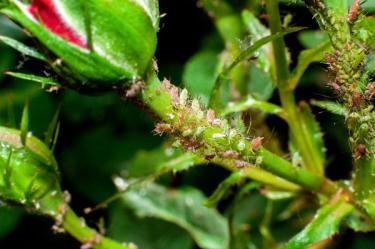
Aphids
Type of pest: Insect
How to ID: Many species; adults are typically 1/16-1/8 inch long, soft-bodied, with colors varying from pink, green, tan, or black. All aphids have two “tail pipes” at the rear end. Many life stages may be present at once.
Lifecycle: Active spring-fall.
Where you’ll find it in your yard: Aphids feed on most garden plants. You’ll often find them on the underside of leaves or on stems of plants that look shiny or feel sticky to the touch. Sometimes leaves will curl closed—open these to check and see if aphids are present.
Damage: Aphids have needle-like mouthparts they use to suck and feed on plant sap. Typically, aphids won’t kill a plant, but they can cause leaf curling or yellowing, bloom failure, and carry plant viruses. Aphids also produce honeydew, a sugary substance that makes plants look wet and sticky and which can lead to disease as mold builds up on the sweet, sticky honeydew.
How to manage: Remove weeds, which can support aphids, and spray plants with a garden hose to remove aphids and honeydew.
Product recommendations: Monterey® Garden Neem Oil RTU and Monterey® Garden Horticultural Oil RTU
Sunday Tip:
Often when aphids are present, you might see ants on your plants as well. The ants aren’t feeding on your plant—they are “farming” and protecting the aphids. In return, they get to feed on the aphid honeydew for a quick, sugary snack (yum!).
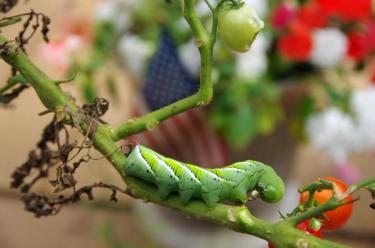
Caterpillars
Type of pest: Insect
How to ID: There are many species of caterpillars, but in general, they have soft, segmented bodies, are typically 1/2-4 inches long, come in a variety of colors and patterns, and have 2-5 pairs of “prolegs” or fleshy false legs. Some even have hairs or spines.
Lookalike: Sawflies, which will have 6-10 pairs of prolegs.
Lifecycle: Most caterpillars overwinter as eggs or pupae and are active spring-fall, depending on the species.
Where you’ll find it in your yard: Caterpillars feed on a variety of garden plants, but can often be found on the top or bottom of plant leaves being fed on.
Damage: Caterpillars leave behind chewed leaf tissue and frass (excrement); damage is typically more cosmetic, but can become severe in some cases and lead to reduced plant health, or death.
How to manage: Keep plants healthy so they can tolerate some feeding and plant a bird-friendly yard to promote natural predators. If you do need to get rid of a few particularly pesky caterpillars, hand remove when possible (you can use tools or gloves for protection), and drop in soapy water or the trash. And keep in mind—those caterpillars may turn into important pollinators one day, so tolerate a few caterpillars when possible!
Product recommendations: Monterey® Garden Neem Oil RTU
Sunday Tip:
Many caterpillars have very specific host-plant needs, and can only feed on a specific type of plant (think monarch caterpillars and milkweed plants).
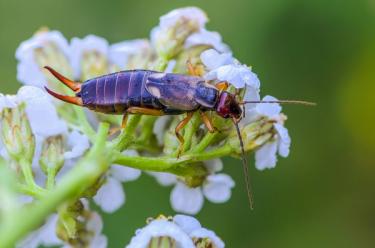
Earwigs
Type of pest: Insect
How to ID: Around 5/8 inch long, brownish red insects with forcep-like appendages at the rear.
Lookalikes: Beetles—key ID are the earwig forceps.
Lifecycle: Earwigs are most active in the garden at night during the summer.
Where you’ll find it in your yard: During the day, earwigs will hide in or under flower pots, wood piles, or at the base of trees or shrubs. They particularly like to feed on marigolds, dahlias, butterfly bush and hostas.
Damage: Earwigs may damage or feed on some vegetable plants or leaves or may dig holes in flower blossoms. Damage is often not severe—these are more of a fear-inducing or nuisance pest in the garden (and home! But don’t worry, earwig forceps might look scary, but they aren’t strong enough to pinch humans!).
How to manage: Remove debris, leaf, or wood piles to reduce habitat. Oil traps can be used to monitor and trap earwigs: Fill a deep can with 1/2 inch of vegetable or fish oil and place in the ground so the lip is level with the soil. This is another “pest” we like to tolerate when possible, though—earwigs feed on many other garden pests like aphids and insect eggs.
Product recommendations: Bug Doom Home Barrier Spray Gallon with Wand and Ant Adios Insect & Ant Killer
Note: You should not spray Bug Doom directly on plants, and Ant Adios has use restrictions around application date before harvest and maximum applications around edible plants. Read the label for more information.
Sunday Tip:
The shape of the forceps can tell you if an earwig is male or female: Males have strongly curved forceps, while females are more slender, straight, and close together.
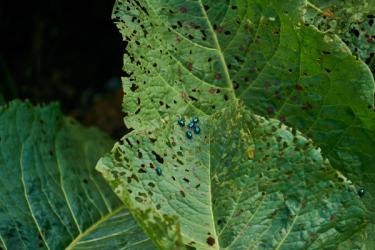
Flea Beetle
Type of pest: Insect
How to ID: There are various species of flea beetles, but adults are typically between 1/16 and 1/5 inch long. They are oval, blue-green to black in color, may be striped or patterned, and have enlarged hind legs—the better for jumping with. Larvae are small, white, cylindrical, and less than 1/3 inch long, with a brown head and long legs.
Lifecycle: Active spring-summer.
Where you’ll find it in your yard: Flea beetles are most commonly found in veggie gardens, and particularly like cabbage, tomato, potato, cucumber, melon, grape, spinach, eggplant and relatives
Damage: Adults chew many small holes in leaves, and heavy infestations can cause plant death. Larvae feed on roots.
How to manage:
On cool days or early mornings, brush beetles off leaves into a bowl of soapy water. Barriers such as row covers can help protect vulnerable crops if installed at planting. Remove weeds to reduce habitat.
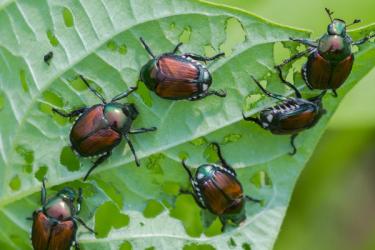
Japanese Beetle
Type of pest: Insect
How to ID: Adults are 1/3-1/2 inch long with a metallic green head and thorax (neck area) and copper wing covers.
Lifecycle: Adults are most active in the garden in summer, but Japanese beetle larvae are part of the complex of white grub species that can cause spring damage to lawns.
Where you’ll find it in your yard: Adult Japanese beetles feed on more than 300 species of flowers, trees, shrubs, and veggie plants, but favorites include roses and Prunus trees (cherry, plum, peaches, and relatives).
Damage: Skeletonized or lacey-looking leaves are the most common damage caused by Japanese beetles, and is usually more cosmetic than outright damaging, but they can also feed on flowers and fruits. Young plants are more susceptible than older, well-established plants.
How to manage: Healthy plants can tolerate quite a bit of feeding. Harvest your fruit and veggies regularly to reduce damage between harvests. Scout in the evening or early morning when beetles are “sluggish” and physically remove by knocking beetles into a bowl of soapy water. It is important to remove beetles from plants to reduce damage, because damaged plants emit chemicals that attract more Japanese beetles. Non-flowering or fruiting plants can be covered with netting during the summer to protect leaves, without reducing pollination required for fruit-set. Do not use traps - they usually are not effective and can attract more insects to the garden.
Product recommendations: Monterey® Garden Neem Oil RTU
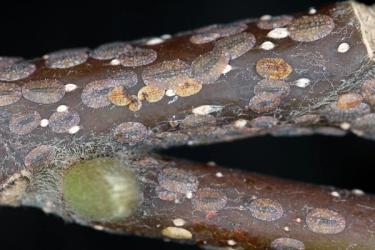
Scale
Type of pest: Insect
How to ID: There are a variety of scale species, but most are about 1/8-1/2 inch long, flat, brown to black in color and come equipped with a scaly or shell-like waxy protective coating.
Lifecycle: This can vary slightly depending on species, but most scales are most active in summer.
Where you’ll find it in your yard: Scales like woody plants like trees and shrubs.
Damage: Just like aphids, scales will suck sap from trees and shrubs. You may see yellow or wilted leaves, stunted growth, and death of part or all of the plant.
How to manage:
Prune and discard of heavily infested stems and promote beneficial predators such as lady beetles and parasitic wasps by planting a diverse garden.
Product recommendations: Monterey® Garden Neem Oil RTU and Monterey® Garden Horticultural Oil RTU
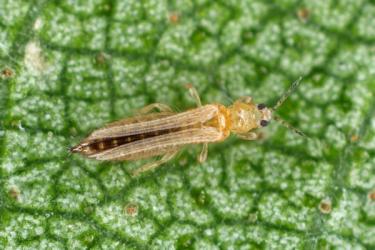
Thrips
Type of pest: Insect
How to ID: Very small (1/32 to 1/8 inch) insects with rice-shaped yellow, brown, or black bodies. Adults have fringed wings.
Lifecycle: Most active in spring.
Where you’ll find it in your yard: Thrips feed on many ornamental and vegetable plants.
Damage: Thrips feed on leaves, leaving behind dry, scarred, or silvery looking leaves with frass on the underside. They can also sometimes attack flowers or flower buds, leading to deformed flowers or failed flowering.
How to manage: Keep plants healthy by watering and feeding properly. Weed surrounding areas to reduce thrip habitat. Spray leaves with water or shake plants to remove thrips.
Product recommendations: Monterey® Garden Horticultural Oil RTU
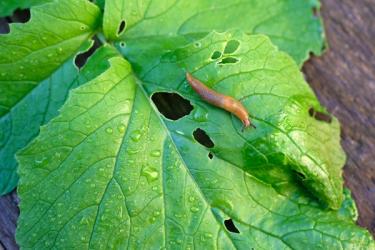
Slugs and snails
Type of pest: Mollusk
How to ID: Both snails and slugs have soft bodies, and produce a slime trail when moving around. Slugs are shell-less but snails have shells.
Lifecycle: Snails and slugs are most active in spring and fall when it is cool and wet. Where you’ll find it in your yard: They often hide under plants or mulch or other moist, dark areas during the day and feed at night. Hostas and garden fruits like tomatoes and berries are favorite feast plants.
Damage: Snails and slugs will feed on fruit and flowers, and create irregular holes on the leaves of ornamental and vegetable plants. They can also leave an unsightly slime trail on surfaces like sidewalks or pavement.
How to manage: Reduce moisture by watering the garden properly, creating a mulch-free zone around the base of plants, and thinning or pruning plants to increase air flow. Remove debris to reduce habitat and overwintering spots. Hand remove if spotted, or use beer traps to monitor and trap slugs and snails in the garden.
Product recommendations: Monterey® Garden Sluggo® Plus
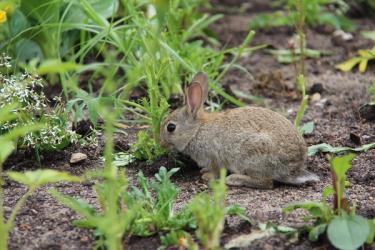
Rabbit
Type of pest: Small mammal
How to ID: Rabbits are relatively small (less than 1 foot long), fluffy mammals, with characteristic long ears and short tails. Presence of pea-sized droppings are an indication of rabbit presence, if you don’t see the bunnies themselves.
Lifecycle: Rabbits feed at night, and can be active year-round.
Where you’ll find it in your yard: Rabbits will seek cover in brush or woodpiles. They feed on many tender vegetable and ornamental plants like lettuce, beans, petunias and pansies.
Damage: Rabbit-damaged plants will have a sharp cut, rather than a ragged or torn appearance, or may completely disappear overnight. They may also dig in the garden on occasion.
How to manage: Plant rabbit-repelling and rabbit-tolerant plants, when possible. Remove debris and weeds to reduce habitat and cover. Fencing with 1 inch mesh, buried at least 6 inches deep can help protect garden areas.
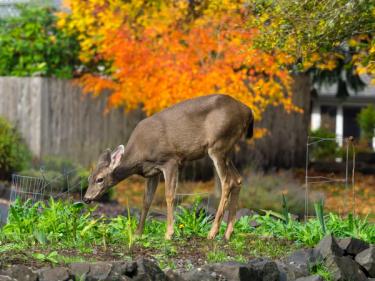
Deer
Type of pest: Large mammal
How to ID: Four-legged, hoofed, large mammals (think a more pest-y Bambi). Color is brown or tan, sometimes with white spots or markings. Males have antlers. Lifecycle: Year-round, but deer usually cause most damage in spring when feeding on new, young, succulent growth.
Where you’ll find it in your yard: Deer can be found pretty much anywhere you have plants in the yard, but often are more reluctant to get close to the home, and can be prevented from entering fenced or netted areas.
Damage: When deer run through your garden, you’ll notice torn or missing leaves, shredded twigs, and trampled plants. In severe cases, entire plants may go missing. Buck rubs or stripped bark on trunks of woody plants can also indicate deer presence.
How to manage: Plant deer-resistant species or varieties, or plant less desirable plants around susceptible plantings. Barriers and repellants may also be used, though keep in mind that fencing will need to be at least 8 feet tall to prevent deer from jumping over it!
Note: Deer-resistant plants are not necessarily deer-proof; a hungry deer will eat pretty much anything they can get their hooves on.
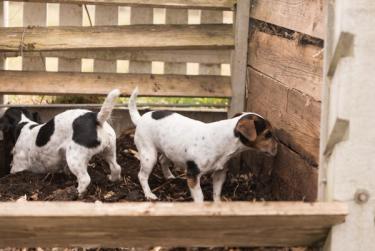
Dog
Type of pest: Large mammal
How to ID: Your (or your neighbor's) four-legged furry friend.
Lifecycle: Year-round.
Where you’ll find it in your yard: Anywhere that isn’t fenced off or where they aren’t trained to avoid.
Damage: Dogs may dig in the garden or trample plants (but they’ll look so darn cute while doing it!).
How to manage: Train your dog to use certain areas of the yard, or fence off areas you want them to avoid.
Cited sources
Aphids in home yards and gardens. University of Minnesota Extension.
Aphids, Mites, and Thrips. University of Florida Institute of Food and Agricultural Sciences.
Caterpillars on ornamental plants.University of Minnesota Extension.
Earwigs. University of New Hampshire.
Earwigs. University of Minnesota Extension.
Flea Beetles. Cornell University.
Home Vegetable Garden Insect Pest Control. Oklahoma State University.
Insect Pests of the Home Vegetable Garden. Mississippi State University Extension.
Japanese beetles in yards and gardens | UMN Extension. University of Minnesota Extension.
Preventing Deer Damage. Colorado State University Extension.
Rabbits. University of Florida, Institute of Food and Agricultural Sciences.
Scale Insects. Iowa State University Extension and Outreach.
Slugs in home gardens. University of Minnesota Extension.












